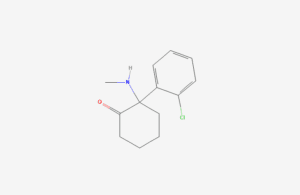
[Image courtesy of PubChem]
However, the question of how the dissociative anesthetic ketamine should be used in the long-term to manage mood order symptoms is less clear.
Pharma efforts in ketamine for depression
First synthesized in 1962, ketamine’s patent expired in 2002. Janssen, however, managed to secure patent protection for Spravato, the S-enantiomer of ketamine that won FDA approval in 2019.
Janssen has not disclosed sales figures for its nasal spray-based Spravato, but GlobalData projects it will generate global sales of roughly $383 million by 2029.
Seelos Therapeutics, is developing intranasal racemic ketamine for acute suicidal ideation and behavior in patients with major depressive disorder (MDD). The company is currently enrolling participants in a Phase 2 study.
Working with partner Develco Pharma, HMNC Brain Health is working to develop a low dose version of ketamine that minimizes dissociative symptoms while maintaining a therapeutic benefit. Recipients of the low-dose ketamine might take a tablet per week for six months.
Other players looking to innovate with ketamine
In the past few years, hundreds of clinics have popped up across the company offering traditional IV or IM ketamine as an off-label ketamine treatment. A single infusion could cost roughly $400 to $1,000 and is not covered by insurance.
At the same time, a growing number of psychotherapists are also offering ketamine-assisted psychotherapy, which might cost $1,000 for a single session, depending on the location.
Proponents of the latter approach believe that pairing ketamine with psychotherapy can catalyze longer-lasting change than administering ketamine alone.
Differentiation in the online ketamine marketplace
During the pandemic, several online vendors began taking advantage of relaxed telehealth restrictions to offer mail-order ketamine. Among them are Mindbloom, Better U, My Ketamine Home and Nue Life.

Demian Bellumio
The latter company aims to stand out from the crowd by offering a more technologically-forward integrated approach to ketamine therapy. Its Nue Care aftercare program is designed to help patients monitor progress for six months after completing the company’s ketamine program. The aftercare program includes six health coaching sessions, 24 group integration sessions, three medical consultations and a dozen integration specialist check-ins.
Nue Life announced the availability of Nue Care in mid-September.
The program uses a scoring system to track participants’ mental and physical health across multiple dimensions.
“From day one, we knew at-home technology had to be at the center of everything that we do to ensure safety and that we are collecting the right data to understand how the patient is doing,” said Demian Bellumio, co-founder and chief operating officer at Nue Life.
The company built its own EMR technology to ensure the bidirectional flow of information between a given patient and healthcare providers. “We had to combine a number of different views of the patient that traditionally were not supported by an EMR,” Bellumio said.
Nue Life’s app can allow users to track everything from mood to sleep and exercise. The app also includes a proprietary music streaming service with curated playlists.
The company has served close to 6,000 patients to date.
Minimizing reliance on ketamine while promoting mental health
Nue Life seeks to use ketamine as a relatively short-term catalyst for change rather than a long-term maintenance therapy. “We wanted to help the patient create goals and stick to them,” Bellumio said. “We can measure those goals and communicate information related to the patient seamlessly. And the patient has a multidisciplinary team supporting him or her.”
Acknowledging that a significant number of depressed patients find little benefit from SSRIs, Nue Life notes that ketamine can work as a quick-acting antidepressant that allows an opportunity to lay the foundation for future change. A recent study published in Frontiers in Psychiatry found that three doses of sublingual ketamine in combination with telehealth yielded a roughly 60% reduction in depression symptoms based on Patient Health Questionnaire-9 (PHQ-9) scores. Depression and anxiety scores continued to improve for patients with treatment-resistant depression who took six doses.
“Our team believes that what ketamine does is just the first step in our process,” Bellumio said. “It opens up a window where potentially a person with severe depression feels okay for the first time. They might actually feel positive and like they can start making decisions.”
That program hopes not to use more ketamine to keep the window open but to use health coaching and integration work instead.
Nue Life’s medical staff feels that a holistic conservative approach to ketamine is “more responsible” than relying on a drug to do the heavy lifting. “Mental health is a complex problem. It has many different dimensions,” Bellumio said. “Being able to track how patients sleep, exercise, and all of these other data points we’re collecting has never been done before.”
One of the most common criticisms of the mental health industry involves the difficulty of measuring outcomes. “Very few outcomes are being measured anywhere,” Bellumio said. “Now we have an almost daily connection with our patients. We’re measuring outcomes on an almost ongoing basis. So we’re very excited about the potential of this therapy in the future as we gather more and more data on patients.”
Filed Under: Psychiatric/psychotropic drugs





Tell Us What You Think!
You must be logged in to post a comment.